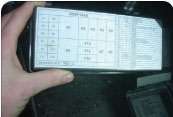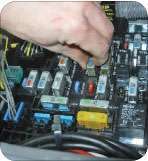Fuse blues
When something goes wrong in wiring or an accessory, the flow of electrical current can create heat that damages wiring and accessories or even starts a fire. Fuses contain a soft conductor that melts easily. When a short circuit or overload happens, the fuse will quickly melt and break the circuit, killing power to it before there is too much heat.
You can tell a fuse is blown by looking through the clear plastic. You’ll see solid, bright metal when it’s OK and a separation in the metal when it’s blown. When a fuse blows, suspect electrical system trouble, but it’s worthwhile to try a replacement fuse first. If it blows again, diagnose the problem and repair.



4. Turn off the ignition, or, if dealing with a circuit not controlled by the key, turn off all accessories on that circuit.
5. Pull the fuse straight out. If it doesn’t protrude far enough to grab it, gently pull it with a narrow pair of pliers.

7. Replace the cover by inserting the prongs through the hinges, rocking it closed and forcing it downward until the attaching clips or locking mechanism latch tightly.
Tools
• Narrow-jawed or needle-nose pliers
• Rags
• New fuse










